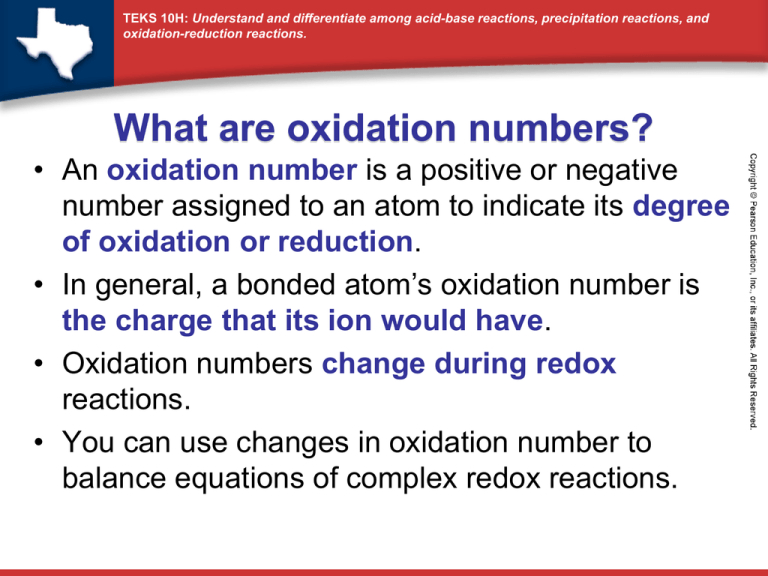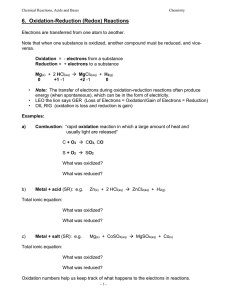What are oxidation numbers?
advertisement

TEKS 10H: Understand and differentiate among acid-base reactions, precipitation reactions, and oxidation-reduction reactions. What are oxidation numbers? • An oxidation number is a positive or negative number assigned to an atom to indicate its degree of oxidation or reduction. • In general, a bonded atom’s oxidation number is the charge that its ion would have. • Oxidation numbers change during redox reactions. • You can use changes in oxidation number to balance equations of complex redox reactions. Rules for Oxidation Numbers TEKS 10H: Understand and Assigning differentiate among acid-base reactions, precipitation reactions, and oxidation-reduction reactions. 1. The oxidation number of a monatomic ion is equal in magnitude and sign to its ionic charge. For example, the oxidation number of (Br1–) is –1. 2. The oxidation number of hydrogen in a compound is +1, except in metal hydrides, such as NaH, where it is –1. 3. The oxidation number of oxygen in a compound is –2, except in peroxides—such as H2O2—where it is –1, and in compounds with the more electronegative fluorine, where it is positive. 4. The oxidation number of an atom in uncombined (elemental) form is 0. 5. For any neutral compound, the sum of the oxidation numbers of the atoms in the compound must equal 0. 6. For a polyatomic ion, the sum of the oxidation numbers must equal the ionic charge of the ion. TEKS 10H: Understand and differentiate among acid-base reactions, precipitation reactions, and oxidation-reduction reactions. Sample Problem: Assigning Oxidation Numbers to Atoms What is the oxidation number of each atom in SO2? TEKS 10H: Understand and differentiate among acid-base reactions, precipitation reactions, and oxidation-reduction reactions. What are oxidation reduction reactions? • Oxidation-reduction reactions involve the oxidation of a reactant and the reduction of another reactant. • Early chemists viewed oxidation as the gain of oxygen by an element; reduction was viewed as the loss of oxygen by a compound: Oxidation: A gain of oxygen Reduction: A loss of oxygen • Modern chemists define oxidation-reduction reactions in terms of a shift of electrons between reactants: Oxidation: A gain of oxygen OR a loss of electrons Reduction: A loss of oxygen OR a gain of electrons • Oxidation-reduction reactions are also called redox reactions. TEKS 10H: Understand and differentiate among acid-base reactions, precipitation reactions, and oxidation-reduction reactions. Magnesium metal can react with sulfur, forming magnesium sulfide. In this reaction, magnesium atoms lose two electrons and sulfur atoms gain two electrons: Magnesium is oxidized, and sulfur is reduced. TEKS 10H: Understand and differentiate among acid-base reactions, precipitation reactions, and oxidation-reduction reactions. How do oxidation numbers change in chemical reactions? In any redox reaction, the oxidation numbers of reacting species change. One reactant is oxidized and another is reduced. +1 +5 — 2 0 +2 +5 — 2 0 2AgNO 3 (aq) + Cu( s) Cu(NO 3 ) 2 (aq) + 2Ag ( s) In this reaction, the oxidation number of Ag decreases from +1 to 0. It gains an electron and is reduced to silver metal. The oxidation number of copper increases from 0 to +2. It loses two electrons and is oxidized. • Oxidation is an increase in oxidation number. • Reduction is a decrease in oxidation number. TEKS 10H: Understand and differentiate among acid-base reactions, precipitation reactions, and oxidation-reduction reactions. A substance that undergoes oxidation loses electrons. It is also the reducing agent. A substance that undergoes reduction gains electrons. It is also the oxidizing agent. Silver nitrate reacts with copper to form copper(II) nitrate and silver. The equation may be written in ionic form: 2Ag++ 2NO3– + Cu Cu2+ + 2NO3– + 2Ag Copper is oxidized and silver is reduced. Cu Cu2+ + 2e– (loss of electrons) 2Ag++ 2e– 2Ag (gain of electrons) Copper is the reducing agent silver is the oxidizing agent. TEKS 10H: Understand and differentiate among acid-base reactions, precipitation reactions, and oxidation-reduction reactions. Processes Leading to Oxidation and Reduction Oxidation Reduction Complete loss of electrons (ionic reactions) Complete gain of electrons (ionic reactions) Shift of electrons away from an atom in a covalent bond Shift of electrons toward an atom in a covalent bond Gain of oxygen Loss of oxygen Loss of hydrogen by a covalent compound Gain of hydrogen by a covalent compound Increase in oxidation number Decrease in oxidation number TEKS 10H: Understand and differentiate among acid-base reactions, precipitation reactions, and oxidation-reduction reactions. Sample Problem Identify what is oxidized, what is reducing, what is the reducing agent, and what is the oxidizing agent for this reaction: CuSO4 + Al -------> Cu + Al2(SO4)3 TEKS 10H: Understand and differentiate among acid-base reactions, precipitation reactions, and oxidation-reduction reactions. How do you balance redox reactions? One way to balance redox reactions is to use the oxidation-numberchange method. The following steps are used in this method: • Write the skeleton equation for the reaction. • Assign oxidation numbers to all the atoms in the equation. • Identify which atoms are oxidized and which are reduced. • Use a bracketed line to connect oxidized atoms that are oxidized and another line to connect atoms that are reduced. Write the oxidation-number change on the line. TEKS 10H: Understand and differentiate among acid-base reactions, precipitation reactions, and oxidation-reduction reactions. • For example, the equation for the process used to obtain metallic iron from iron ore in a blast furnace would appear as follows: • Make the total increase in oxidation number equal to the total decrease by using coefficients.






